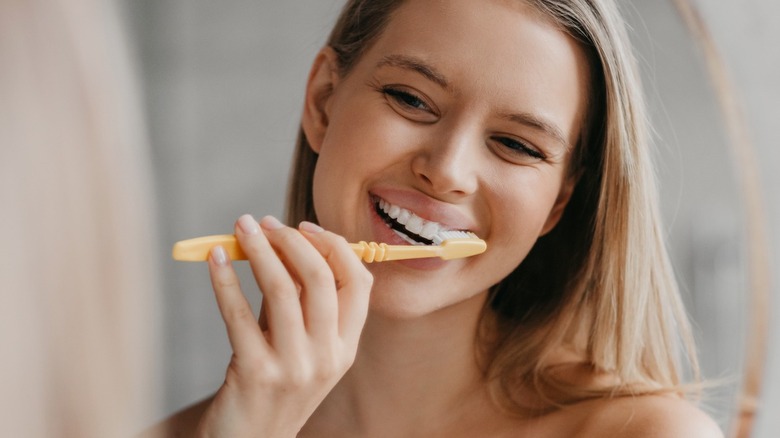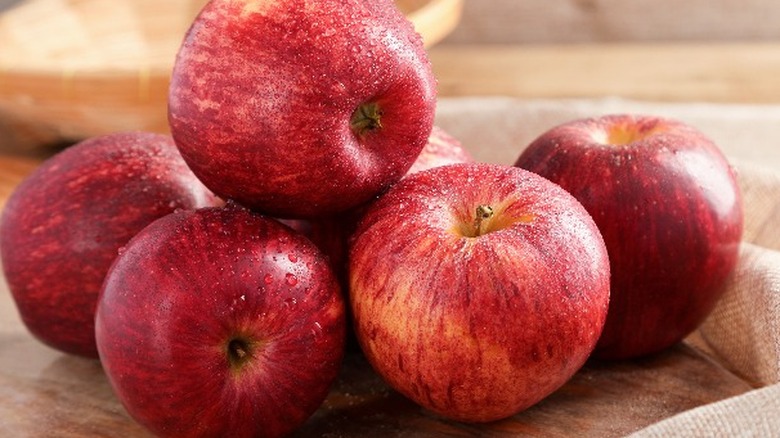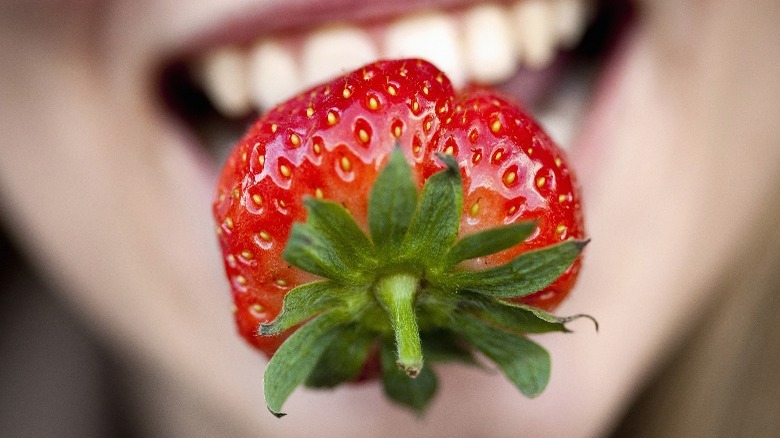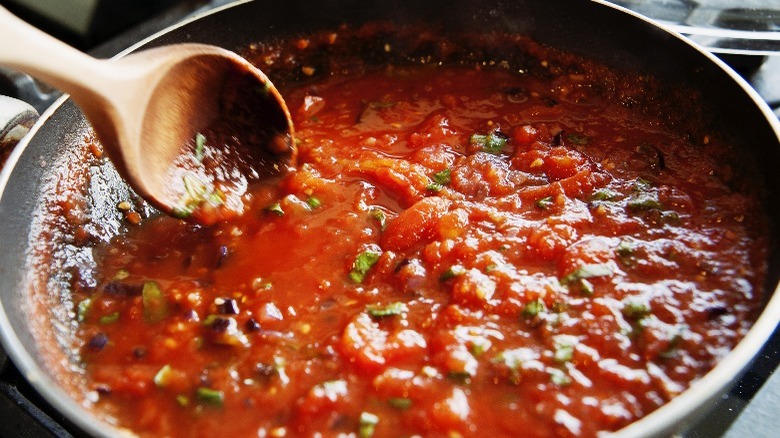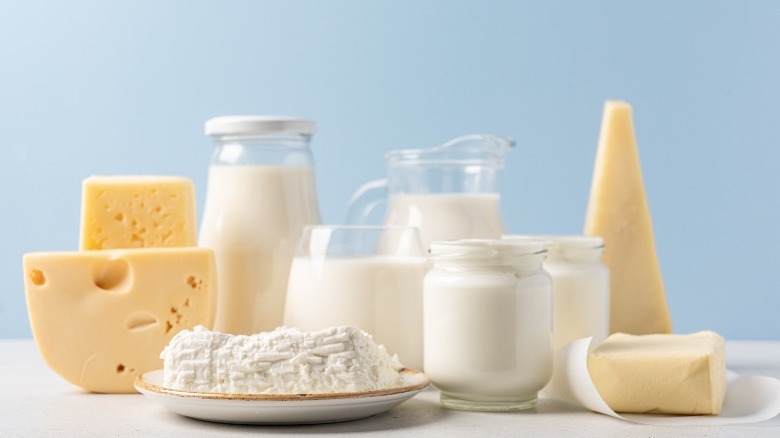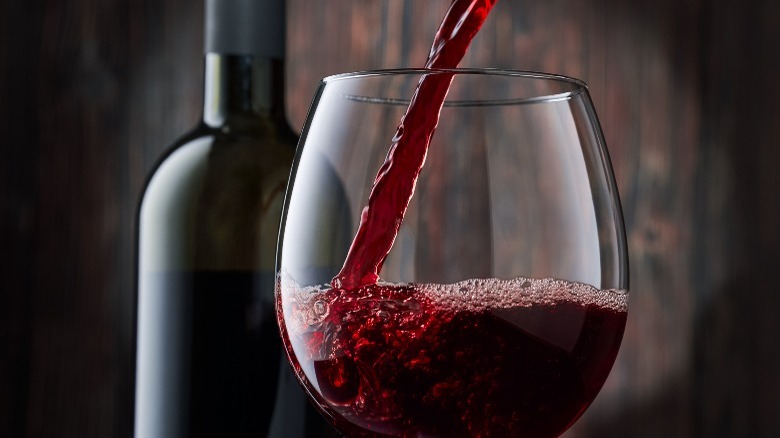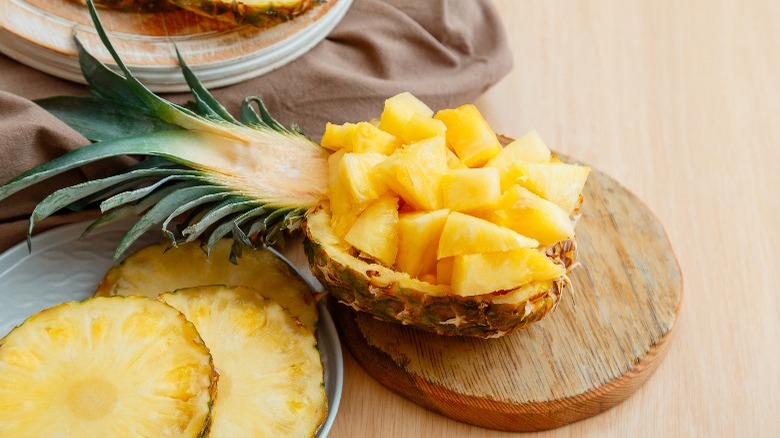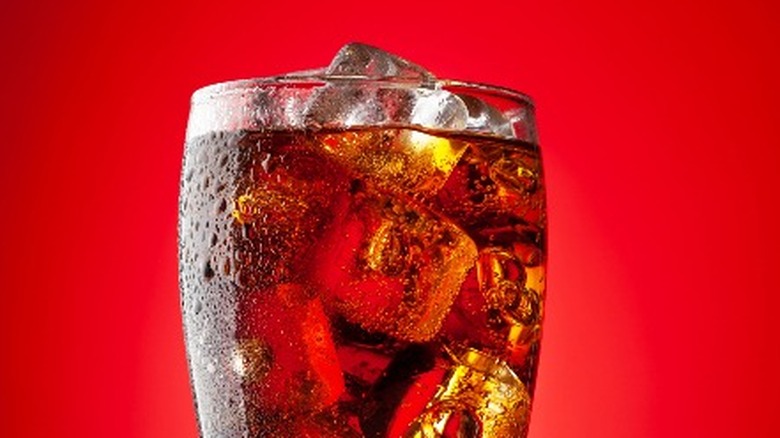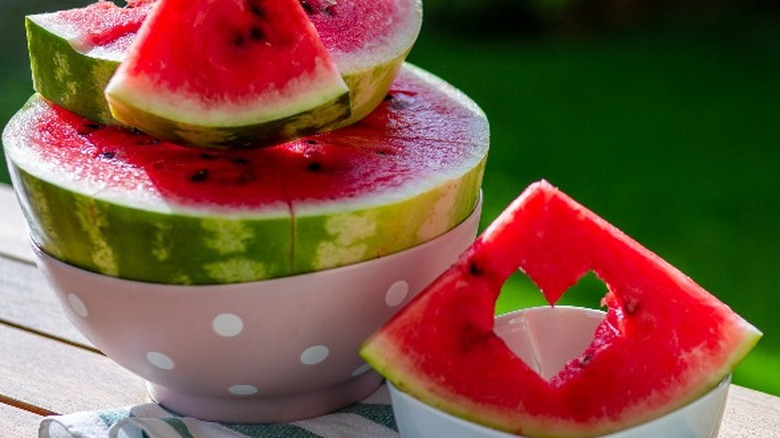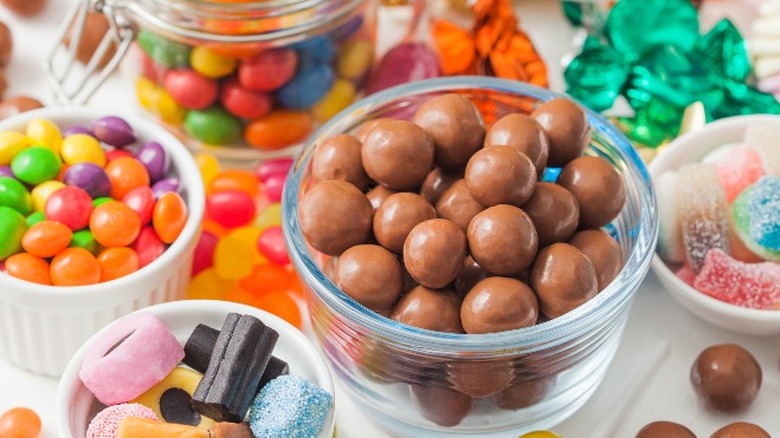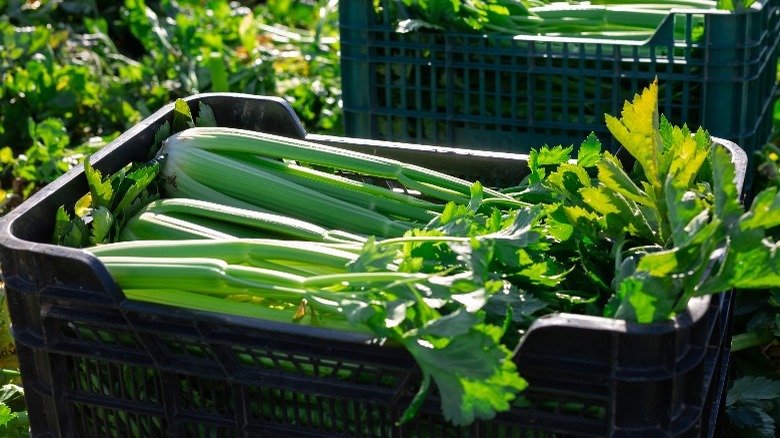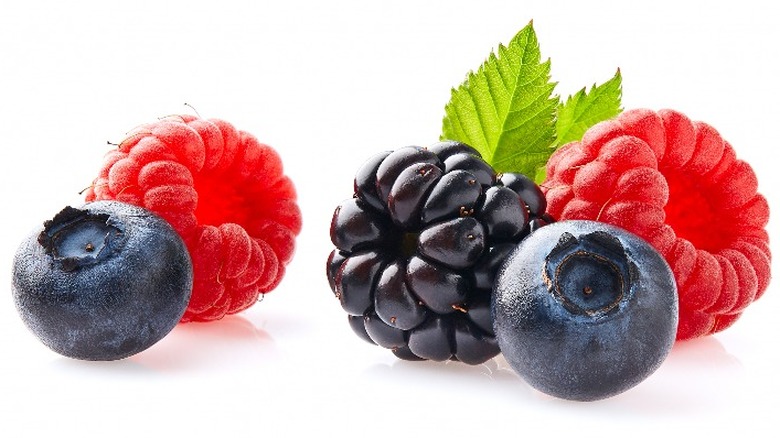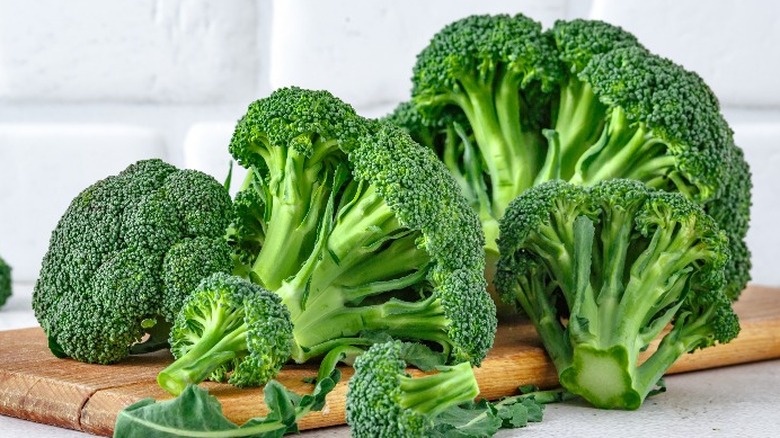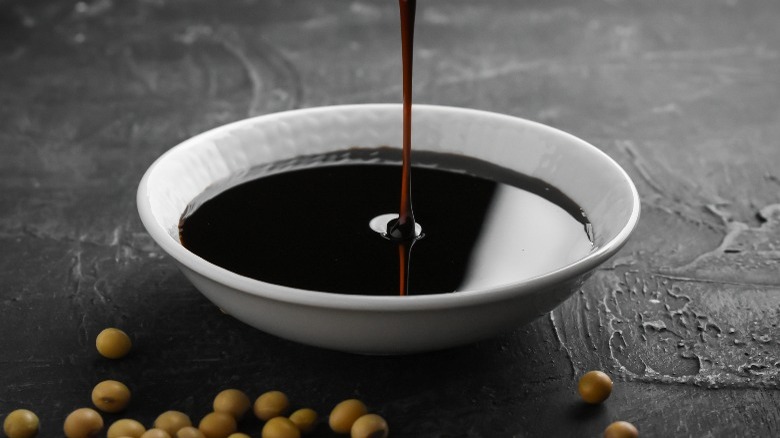7 Foods To Eat And 7 To Avoid To Whiten Your Teeth
Teeth staining is an unfortunate part of life. While consistent oral hygiene and dental care will help, there are several things that can cause your teeth to turn yellow or become less vibrant over time. For one, what you eat can impact the color and brightness of your smile, with dark-colored foods and beverages potentially staining teeth (per WebMD). Tobacco use is another major risk factor for yellowing teeth.
A stained smile is also associated with aging and a characteristic that makes you less attractive. As explained by Crest, tooth enamel wears down with age and reveals the natural yellowish color of the tooth's dentin. Additionally, a study published in PLoS One found that participants rated those with yellow teeth as significantly less attractive than those with white teeth — especially women.
With all the negative associations connected to stained teeth, it's no wonder that the dental aisle at grocery stores and pharmacies are flooded with teeth-whitening products that promise dramatic results in just one application. However, you can also ensure your teeth stay as radiant as possible by preventing stains from happening in the first place. To help you keep your smile on track, here are some foods you should eat and some you should avoid to keep your teeth bright and white.
Eat: Apples
Apples provide several nutritional and health benefits, including a good dose of fiber and antioxidants that have anti-inflammatory, antiviral, and anticancer properties. The plant compounds in apples can also help to balance blood sugar levels, lower cholesterol, improve brain function, and fight depression.
In addition to their numerous health-boosting effects, apples may be a good thing to reach for when you can't brush your teeth right away. According to a study in PLoS One, chewing an apple immediately reduces the bacteria found in saliva at a comparable level to tooth brushing. The College of Dentistry at the University of Illinois, Chicago also shares that a fresh apple can increase saliva flow, which decreases the acidity level in the mouth. This reduction of bacteria and acidity can lower the risk of developing tooth decay, which can lead to grayish or black discoloration of the teeth (per WebMD).
However, the dental benefits of apples are definitely not a substitute for brushing and flossing. While apples may have short-term perks, the PLoS One study also found that apples do not remove dental plaque, which can eat away at your tooth enamel.
Avoid: Coffee and tea
No matter how vigilant you are about brushing and flossing, the culmination of years of drinking tea or coffee will eventually take its toll on your teeth. Both coffee and tea contain tannins that break down in water and can stick to the enamel on your teeth. Over time, these tannins may cause a brownish or yellowish hue on the teeth that is difficult to remove.
Unfortunately, giving up coffee or tea in the name of a brighter smile may be easier said than done. You may rely on that boost of caffeine in the mornings or late afternoons to help keep you going on those long, busy days. However, reducing the amount of coffee or tea you drink or changing the way you consume them may help to protect your teeth from staining.
For example, stick to just one cup in the morning and drink it all at once rather than sipping on it throughout the day. Also, drinking water right after coffee or tea can help rinse your mouth and remove some of the teeth-staining tannins. Although you may assume that brushing your teeth right after drinking coffee is a good idea, it may actually damage your enamel. According to the Huffington Post, dentists suggest waiting about 30 minutes to allow your mouth's acidity levels to return to normal. In the article, Dr. Sonya Krasilnikov explains, "You don't want to be brushing when your environment is acidic, it's chemically abrasive."
Eat: Strawberries
While the deep red color of strawberries might make you steer clear of them when you're trying to keep your teeth white, they may actually help to brighten your smile. A study published in the Padjadjaran Journal of Dentistry found that strawberry juice was able to whiten teeth more effectively than mineral water or apple juice because of its higher concentrations of hydrogen peroxide, ellagic acid, and malic acid.
Additionally, a review published in the Journal of Oral Biosciences shared that strawberries and some other fruits naturally contain ingredients that can whiten teeth at much safer levels than commercial whitening products. When hydrogen peroxide and carbamide peroxide are highly concentrated, they can be harmful to teeth by breaking down enamel. Because strawberries contain mild levels of whitening ingredients, they don't pose the same threat.
Of course, you still want to keep up with your dental hygiene routine and see your dentist regularly for teeth cleanings if you want a bright smile. Although strawberries may have some whitening properties, they do not remove bacteria or plaque from your teeth or gums.
Avoid: Tomato sauce
Tomato sauce is a staple in many recipes and types of cuisines, including pasta sauce and other Italian-inspired dishes. Although tomato sauce packs a punch of flavor, it's also a very acidic food that can be harmful to your dental health. As explained by the American Dental Association (ADA), acidic foods and beverages wear away tooth enamel, which can result in the yellowing of the teeth, bacteria growth, and other negative effects.
Not only are tomatoes on the acidic side, but they also have a lot of natural color that can stain teeth. Dr. Michael Apa, a dentist and the founder of his own line of oral care products, shared with GQ Magazine that "[tomato sauce] contains a highly pigmented color and is acidic as well. Acidic foods can weaken the enamel layer of your tooth, which can make it more porous and, in turn, more susceptible to stains."
If you must use tomato sauce, you can try reducing acidity levels to help protect your teeth enamel. One way to do this is to add baking soda to your recipe, which is an alkaline that offsets acid. You can also cook the tomato sauce longer than usual to reduce acidity and concentrate the flavors even more.
Eat: Dairy products
Another food category that has some dental benefits is dairy. Milk, cheese, yogurt, and other dairy products are excellent sources of calcium, which helps strengthen teeth enamel. According to Delta Dental, calcium is essential to maintain tooth enamel and prevent erosion and tooth decay. When dental enamel is strong, it's less likely to wear down and expose the yellowish dentin underneath.
While all dairy contains calcium that can boost teeth and bone health, milk may be the most beneficial when it comes to teeth whitening. A study published in the International Journal of Dental Hygiene tested milk's ability to reduce staining when added to tea. The results showed that the combination of cow's milk and tea significantly reduced the tea's ability to stain the teeth. Milk contains a protein called casein, which is responsible for its white color. The study found that casein was what prevented the tea from causing stains on the teeth.
Avoid: Red wine
If you've ever had a glass of red wine, you'll know the effect it has on your teeth is almost immediate. Just like coffee and tea, red wine is packed with tannins that can leave stubborn stains on your teeth. As explained in a Vox article, anthocyanins are what give red wines their deep red pigment, which can cause staining on their own. However, the combination of tannins with this natural pigmentation means that the red color binds more easily to the teeth.
Additionally, red wine is typically acidic, which can start to strip away the enamel on your teeth with repeated exposure (via Crest). When that outer layer of your teeth is damaged and starts to erode, teeth can begin to appear less vibrant. Also, it leaves your teeth exposed and more vulnerable to tooth decay, which can also cause discoloration.
What's interesting, though, is some people experience the dreaded "wine teeth" effect more intensely than others. Dr. Uchenna Akosa of Rutgers School of Dental Medicine told Vox, "Maybe one person is more prone to plaque buildup and the other isn't. Maybe one person has stronger enamel and the other doesn't." These slight differences could mean that one person's teeth are likely to stain a lot more than the next.
Eat: Pineapple
Pineapple is a bright and tasty tropical fruit that boasts several health benefits. Not only are they rich in vitamin C and manganese, but they also contain powerful antioxidants and enzymes that may help with digestion, fight disease and inflammation, boost immunity, and lower the risk of developing certain types of cancers.
Another enzyme found in pineapple juice and stems is bromelain, which may actually help to whiten teeth. As shared by Texas A&M University, bromelain has emerged as a whitening alternative to hydrogen peroxide because it's considered less harsh and damaging to the teeth's enamel. When applied to the teeth with similar applications as peroxide whitening products, bromelain was found to produce similar results without causing damage to the tooth's structure. Moreover, the bromelain did not cause tooth sensitivity, which is often associated with hydrogen peroxide products.
Another study published in the Journal of Conservative Dentistry found that pineapple extract added to hydrogen peroxide provided very effective whitening results. A combination of 10% hydrogen peroxide with pineapple extract showed the same whitening effectiveness as a treatment that contained 30% hydrogen peroxide with no pineapple extract. This could mean whitening product manufacturers may turn to safer plant enzymes like bromelain rather than relying on higher concentrations of harsh chemicals.
Avoid: Soda
If you've noticed that your smile isn't as bright as it used to be, what you're drinking may be the culprit. Carbonated drinks like colas, diet colas, fruity sodas, and ginger ale are incredibly acidic, which means they can damage your teeth. According to Dentistry-Review, acidic sodas erode the teeth's enamel and create an environment in the mouth that promotes bacteria growth that can last for 20 minutes after drinking one of these beverages. As your enamel wears away, so too does your bright, white smile.
Dentistry-Review also shares the worst sodas for your teeth. Dark-colored colas, like Coca-Cola and Pepsi, have the highest acidity levels — between 2.37 and 2.39 on the pH scale. Ginger ale is a close second, with a 2.82 pH level. Sodas that fall into the "fruity" category, including orange and grape sodas, have pH levels right around 3.00. Diet sodas fare slightly better, but they still fall below 4.00 on the pH scale. To give you some perspective, pure water has a pH level of 7.00, which is neutral on the scale.
For those who aren't quite ready to give up their favorite soda, you may be able to avoid some of the harmful effects by moderating your consumption. Also, try drinking your soda with a straw, which can help bypass your teeth, and munching on a snack, which will increase saliva production that can help neutralize the acid.
Eat: Watermelon
On top of being a hydrating fruit that is packed with essential nutrients, it turns out that watermelon may also be a good snack to reach for if you're trying to brighten your smile. According to Healthline, watermelon contains even more malic acid than strawberries, which can help whiten teeth and increase saliva production in the mouth. Because malic acid has natural astringent properties, it helps to prevent teeth staining and may aid in lightening stained teeth.
A study published in the Journal of Oral Science found that malic acid significantly improved salivary flow in patients with dry mouth or xerostomia. As a result, symptoms of dry mouth decreased in the group that used a 1% malic acid spray. Because watermelon is rich in malic acid, it can help stimulate saliva production, which can protect teeth enamel from erosion and rinse away harmful bacteria. Strong dental enamel can keep the teeth vibrant and white.
Avoid: Sweets
It's no secret that foods that are high in sugar are typically not good for your health. Sweets like candy, cakes, cookies, and other sugary snacks can potentially increase your risk of developing diabetes, obesity, heart disease, skin conditions, cancer, depression, and more (via Healthline). Although the occasional sweet treat isn't an immediate cause for concern, consuming too much refined sugar in your diet can also be harmful to your teeth.
Sugary foods can increase bacteria in the mouth, which leads to tooth enamel erosion and discoloration. When sugar enters the mouth, it creates a very acidic environment in which oral bacteria thrive and create plaque buildup. The acid can also wear away the minerals in your enamel, which can lead to yellowing teeth, tooth decay, and cavities.
Some candies and baked goods also contain dyes that can stick to the surface of your teeth and cause staining. The combination of increased acidity in the mouth, weakened teeth enamel, and potent food coloring in sweets can lead to teeth staining that is hard to remove with just brushing.
Eat: Celery
Celery is a crunchy, green vegetable used for its bold texture and flavor. However, it's more than just a recipe ingredient or low-calorie snack. Because celery stalks are so fibrous, the teeth must work to break up those fibers by chewing before you can swallow them (via Myers Dental). The chewing process promotes saliva production, which helps clean the teeth, protect the enamel, and neutralize acids in the mouth. All these things can help keep teeth enamel strong and prevent discoloration.
In addition, celery may have some antimicrobial properties and phenolic compounds that could potentially fight bacterial infections. One study published in Veterinary World found that celery extract effectively treated skin infections in rats by reducing the wound area, inflammation, and bacterial colonization. However, scientific studies have not yet been done to see if the same results apply to humans.
While celery may help to physically remove bacteria and other harmful substances from the teeth, it also provides some vitamin C, vitamin A, calcium, and protein (via WebMD). Vitamin C promotes healthy gums, vitamin A supports strong tooth enamel, and calcium and protein can help protect and rebuild tooth enamel, according to the American Dental Association. When your diet supports good oral health and strong enamel, it's less likely that you'll experience discoloration caused by tooth erosion or decay.
Avoid: Berries
Many berries are naturally rich in dark pigmentation that gives them their deep and vibrant colors. Unfortunately, this pigment can also cause teeth staining if you're not careful. Some types of berries that can leave lasting stains include blueberries, blackberries, raspberries, and mulberries due to their high concentrations of chromogens.
However, there are some things you can do to help prevent these berry stains from taking hold. The Farless Dental Group suggests eating berries with water and not allowing them to sit in the mouth for too long. The water will help rinse the pigmentation from the teeth before they have a chance to settle on the enamel. They also suggest drinking a glass of milk after finishing the berries as a way to neutralize acid in the mouth and get essential calcium to strengthen enamel.
According to WebMD, you should also brush your teeth right away after eating berries. If you can't reach for your toothbrush immediately, rinsing your mouth with water can help remove some of the stain-causing particles from your teeth.
Eat: Broccoli
Broccoli is another powerhouse vegetable that may help keep your teeth strong, healthy, and white. Packed with vitamins, minerals, antioxidants, and plant compounds, broccoli provides a ton of nutritional value that can boost dental health. For example, broccoli is an excellent source of vitamin C. An article published in Frontiers in Nutrition shares that vitamin C can reduce gum disease and inflammation connected to gingivitis, aside from protecting against some oral cancers.
In addition to vitamin C, broccoli is rich in vitamin K, kaempferol, sulforaphane, and beta-carotene. According to Jeffrey L. Erwin, DDS, these vital nutrients help to boost teeth and gum health and fight off periodontal disease, which can be a major risk factor for tooth decay, bone loss in the jaw, and tooth loss.
Bright Dentistry also shares that hard, crunchy vegetables like broccoli may help to remove superficial stains from the teeth when eaten raw. When chewing this fiber-packed vegetable, it gently scrubs away debris from the surfaces of the teeth and promotes more saliva, which has its own slew of stain-fighting benefits. Increased saliva can help rinse the teeth clean while also protecting your teeth enamel (per the American Dental Association).
Avoid: Soy sauce
Soy sauce is a popular Asian condiment used for cooking and seasoning foods. Made from just soybeans, wheat, salt, and water, it is bursting with salty, sweet, and umami flavors — even in small amounts. However, this fermented sauce is also a deep, dark brown color that can potentially stain your teeth. In an interview with Cosmopolitan, Dr. Luke Thorley said that "[soy sauce is] one of the worst offenders for staining teeth because the dark coloring of soy can linger long after your meal is over."
Unfortunately, soy sauce also leans towards the acidic side on the pH scale. VegFAQs shares that soy sauce can range anywhere from 4.5 to 5.5 in acidity, which can potentially affect your teeth's enamel. As the enamel breaks down from the acid, your teeth could potentially become more yellow.
One way to protect your teeth from soy sauce stains is to try watering the soy sauce down or not using much of it. Because soy sauce is so concentrated and the flavor is so potent, you really don't need much to enhance your meal. You can also drink a lot of water when eating anything that contains soy sauce. Not only will this wash away some of the residue, but it can also keep the saliva flowing.

